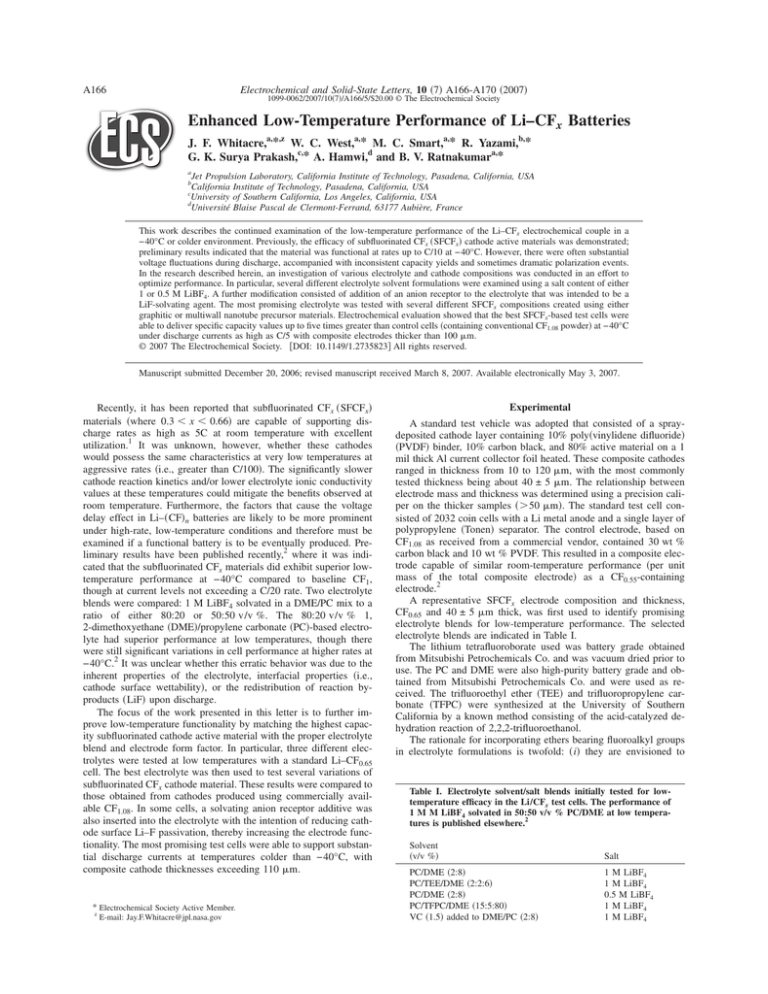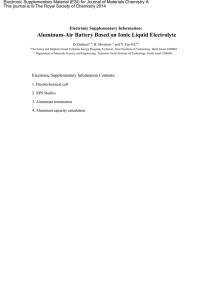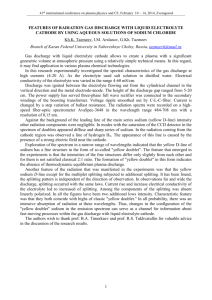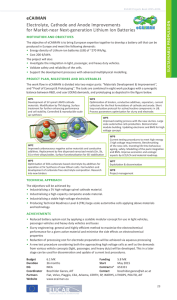
Electrochemical and Solid-State Letters, 10 共7兲 A166-A170 共2007兲
A166
1099-0062/2007/10共7兲/A166/5/$20.00 © The Electrochemical Society
Enhanced Low-Temperature Performance of Li–CFx Batteries
J. F. Whitacre,a,*,z W. C. West,a,* M. C. Smart,a,* R. Yazami,b,*
G. K. Surya Prakash,c,* A. Hamwi,d and B. V. Ratnakumara,*
a
Jet Propulsion Laboratory, California Institute of Technology, Pasadena, California, USA
California Institute of Technology, Pasadena, California, USA
c
University of Southern California, Los Angeles, California, USA
d
Université Blaise Pascal de Clermont-Ferrand, 63177 Aubière, France
b
This work describes the continued examination of the low-temperature performance of the Li–CFx electrochemical couple in a
−40°C or colder environment. Previously, the efficacy of subfluorinated CFx 共SFCFx兲 cathode active materials was demonstrated;
preliminary results indicated that the material was functional at rates up to C/10 at −40°C. However, there were often substantial
voltage fluctuations during discharge, accompanied with inconsistent capacity yields and sometimes dramatic polarization events.
In the research described herein, an investigation of various electrolyte and cathode compositions was conducted in an effort to
optimize performance. In particular, several different electrolyte solvent formulations were examined using a salt content of either
1 or 0.5 M LiBF4. A further modification consisted of addition of an anion receptor to the electrolyte that was intended to be a
LiF-solvating agent. The most promising electrolyte was tested with several different SFCFx compositions created using either
graphitic or multiwall nanotube precursor materials. Electrochemical evaluation showed that the best SFCFx-based test cells were
able to deliver specific capacity values up to five times greater than control cells 共containing conventional CF1.08 powder兲 at −40°C
under discharge currents as high as C/5 with composite electrodes thicker than 100 m.
© 2007 The Electrochemical Society. 关DOI: 10.1149/1.2735823兴 All rights reserved.
Manuscript submitted December 20, 2006; revised manuscript received March 8, 2007. Available electronically May 3, 2007.
Recently, it has been reported that subfluorinated CFx 共SFCFx兲
materials 共where 0.3 ⬍ x ⬍ 0.66兲 are capable of supporting discharge rates as high as 5C at room temperature with excellent
utilization.1 It was unknown, however, whether these cathodes
would possess the same characteristics at very low temperatures at
aggressive rates 共i.e., greater than C/100兲. The significantly slower
cathode reaction kinetics and/or lower electrolyte ionic conductivity
values at these temperatures could mitigate the benefits observed at
room temperature. Furthermore, the factors that cause the voltage
delay effect in Li–共CF兲n batteries are likely to be more prominent
under high-rate, low-temperature conditions and therefore must be
examined if a functional battery is to be eventually produced. Preliminary results have been published recently,2 where it was indicated that the subfluorinated CFx materials did exhibit superior lowtemperature performance at −40°C compared to baseline CF1,
though at current levels not exceeding a C/20 rate. Two electrolyte
blends were compared: 1 M LiBF4 solvated in a DME/PC mix to a
ratio of either 80:20 or 50:50 v/v %. The 80:20 v/v % 1,
2-dimethoxyethane 共DME兲/propylene carbonate 共PC兲-based electrolyte had superior performance at low temperatures, though there
were still significant variations in cell performance at higher rates at
−40°C.2 It was unclear whether this erratic behavior was due to the
inherent properties of the electrolyte, interfacial properties 共i.e.,
cathode surface wettability兲, or the redistribution of reaction byproducts 共LiF兲 upon discharge.
The focus of the work presented in this letter is to further improve low-temperature functionality by matching the highest capacity subfluorinated cathode active material with the proper electrolyte
blend and electrode form factor. In particular, three different electrolytes were tested at low temperatures with a standard Li–CF0.65
cell. The best electrolyte was then used to test several variations of
subfluorinated CFx cathode material. These results were compared to
those obtained from cathodes produced using commercially available CF1.08. In some cells, a solvating anion receptor additive was
also inserted into the electrolyte with the intention of reducing cathode surface Li–F passivation, thereby increasing the electrode functionality. The most promising test cells were able to support substantial discharge currents at temperatures colder than −40°C, with
composite cathode thicknesses exceeding 110 m.
* Electrochemical Society Active Member.
z
E-mail: Jay.F.Whitacre@jpl.nasa.gov
Experimental
A standard test vehicle was adopted that consisted of a spraydeposited cathode layer containing 10% poly共vinylidene difluoride兲
共PVDF兲 binder, 10% carbon black, and 80% active material on a 1
mil thick Al current collector foil heated. These composite cathodes
ranged in thickness from 10 to 120 m, with the most commonly
tested thickness being about 40 ± 5 m. The relationship between
electrode mass and thickness was determined using a precision caliper on the thicker samples 共⬎50 m兲. The standard test cell consisted of 2032 coin cells with a Li metal anode and a single layer of
polypropylene 共Tonen兲 separator. The control electrode, based on
CF1.08 as received from a commercial vendor, contained 30 wt %
carbon black and 10 wt % PVDF. This resulted in a composite electrode capable of similar room-temperature performance 共per unit
mass of the total composite electrode兲 as a CF0.55-containing
electrode.2
A representative SFCFx electrode composition and thickness,
CF0.65 and 40 ± 5 m thick, was first used to identify promising
electrolyte blends for low-temperature performance. The selected
electrolyte blends are indicated in Table I.
The lithium tetrafluoroborate used was battery grade obtained
from Mitsubishi Petrochemicals Co. and was vacuum dried prior to
use. The PC and DME were also high-purity battery grade and obtained from Mitsubishi Petrochemicals Co. and were used as received. The trifluoroethyl ether 共TEE兲 and trifluoropropylene carbonate 共TFPC兲 were synthesized at the University of Southern
California by a known method consisting of the acid-catalyzed dehydration reaction of 2,2,2-trifluoroethanol.
The rationale for incorporating ethers bearing fluoroalkyl groups
in electrolyte formulations is twofold: 共i兲 they are envisioned to
Table I. Electrolyte solvent/salt blends initially tested for lowtemperature efficacy in the Li/CFx test cells. The performance of
1 M M LiBF4 solvated in 50:50 v/v % PC/DME at low temperatures is published elsewhere.2
Solvent
共v/v %兲
Salt
PC/DME 共2:8兲
PC/TEE/DME 共2:2:6兲
PC/DME 共2:8兲
PC/TFPC/DME 共15:5:80兲
VC 共1.5兲 added to DME/PC 共2:8兲
1 M LiBF4
1 M LiBF4
0.5 M LiBF4
1 M LiBF4
1 M LiBF4
Electrochemical and Solid-State Letters, 10 共7兲 A166-A170 共2007兲
A167
Figure 1. 共Color online兲 Discharge data
from Li–CF0.65 test cells at −40°C at a
C/10 rate. All electrodes were 40 ± 5 m
in thickness. Five different electrolytes are
compared here. The two cells that offered
very little capacity at this discharge rate
were then subsequently discharged at a
C/40 rate and yielded full capacity
共500 mAh/g above 1.5 V兲.
impart beneficial physical properties to the electrolyte, due to their
low viscosity, low melting points, and good solvating properties, and
共ii兲 the hydrofluorocarbon ethers are anticipated to better wet the
CFx electrode, improving the interfacial properties. The optimization
of the PC+DME blends is based upon the balance of having an
adequate proportion of the high dielectric constant component 共PC兲
and a sufficient proportion of the low-viscosity, good coordinating
component 共DME兲. During the course of optimization of these electrolytes for low-temperature operation, higher conductivity is observed with electrolyte formulations containing low PC content and
low electrolyte salt concentration. In addition to these factors, the
primary solvent, propylene carbonate or PC, needs to be in adequate
proportion to impart passivation to the anode 共and hence shelf life to
the cell兲 but not high enough to contribute to higher viscosity at low
temperatures.
Upon determining the highest performing electrolyte, at low temperatures, of those examined, test cells were made and tested using
four different cathode active materials; three were SFCFx-based, and
the last was the CF1.08-based standard. The SFCFx fabrication process is described elsewhere.3 The CF0.65 electrodes used partially
fluorinated Madagascar graphite precursor, while the other two
SFCFx variations contained CF0.59 or CF0.82 material made using
multiwall carbon nanotube material precursor materials supplied by
MER Corporation 共Tucson, AZ兲. Characterization data indicated that
all of the SF CFx materials were comprised of pristine unfluorinated
graphite domains mixed intimately with nanodispersed near-fully
fluorinated graphitic regions and are consistent with data reported
previously.1-3 The small scale of these regions dictates that the materials had a very high graphite-to-CF surface area and subsequently
might possess excellent electronic/interfacial transport properties.
In several of the 0.5 M LiBF4 in DME/PC 共80:20兲 containing
cells, an anion receptor Lewis acid additive, tris共2,2,2-trifluoroethyl兲
borate 共TTFEB兲, was also dissolved into the electrolyte solvent in an
effort to decrease or eliminate the LiF 共discharge reactant兲 electrode
surface buildup via a F− complexing reaction. Such an approach has
been employed elsewhere, with a variety of anion receptor molecules in Li-ion battery electrolytes, mainly to enhance the solubility
of lithium salts.4-6 The nominal TTFEB concentration in the electrolyte solution was 1.5:98 v/v % TTFEB/共DME/PC兲 共80:20兲.
Previous work indicated that a room-temperature predischarge
step 共consisting of a 1 h, discharge at a C/33 current level兲 was
necessary to prepare the electrode interfacial regions to accommodate low-temperature discharge.2 This preparation was used here for
most test cells; however, the necessity of this predischarge was reexamined for the most promising electrode/electrolyte combinations. In all cases, the C rate was calculated based on the expected
room-temperature capacity of the cathode if discharged at a C/40
rate.
Results
Figure 1 shows discharge data from CF0.64 SFCFx active-material
cells using a C/10 discharge rate at −40°C with the different electrolytes listed in Table I. The best 共highest power, smoothest discharge curve兲 result was obtained with 0.5 M LiBF4 solvated in an
8:2 v/v % DME/PC blend. Test cells made with electrolytes that
had a higher salt content 共1 M兲, were more rate-limited and had
erratic potential variations during discharge at these low temperatures. Repeated testing supports this finding. Those cells that polarized rapidly were still functional and displayed smooth discharge
curves and good discharge capacities at lower rates 共C/20 or slower兲
at −40°C.
The execution of the predischarge step in the 0.5 M salt content
cells was found to have no beneficial effect on low-temperature
performance, in contrast to the results obtained using electrolytes
containing higher salt concentrations. Electrical impedence spectroscopy 共EIS兲 data collected from test coin cells with stainless steel
blocking electrodes indicate that the 1 M salt-content electrolyte had
approximately twice the high-frequency, real-axis intercept at
−40°C compared to the 0.5 M salt-containing blend. Figure 2 shows
EIS data from Li/CF0.64 cells with either a 1 or 0.5 M salt content.
Figure 2c contains the same data for a 0.5 M salt-content cell with
the anion-receptor additive. All of these cells had similar active
material masses and similar impedance characteristics after discharge.
Figure 3 shows a comparison between the −40°C temperature
performances of various CFx cathodes 共of similar mass/thickness兲 as
discharged at the C/5 rate using the 0.5 M LiBF4 solvated in
8:2 v/v % DME/PC electrolyte. The thickness of the CF1.08-based
cathode was 35 m, while the thickness of the SFCFx cathodes was
A168
Electrochemical and Solid-State Letters, 10 共7兲 A166-A170 共2007兲
Figure 3. 共Color online兲 Discharge data from various Li–CFx test cells at
−40 °C at a C/5 rate. All cells were 40 ± 5 m in thickness. The cells
containing SFCFx yielded significantly more capacity at higher discharge
potentials than that for the cell containing commercially available CF1.08. The
highest capacity material was CF0.82 共multiwalled nanotube, MWNT, precursor兲, which delivered over 650 mAh/g above 1.5 V. The open squares are
data from the thickest of the SFCFX electrodes 共57 m兲.
the CF1.08 baseline cathode under identical discharge conditions.
Multiple electrodes were tested for each electrode composition with
consistent results.
The composite cathode thickness has previously been found to
have a strong negative correlation with the maximum usable discharge rate or realized discharge capacity in the Li–CFx chemistry
and was therefore examined here under low-temperature
conditions.7,8 Figure 4 shows the behavior of CF0.65 composite cathodes with thicknesses varying from 4 to 118 m at a C/5 discharge
Figure 2. 共Color online兲 EIS data collected from Li–CF0.65 cells before and
after full discharge at −40°C with 8:2 v/v % DME/PC electrolyte solvent
using 共a兲 1 M LiBF4, 共b兲 0.5 M LiBF4, and 共c兲 0.5 M LiBF4 with anion
receptor. The frequency range was 100,000 Hz to 50 mHz, while the cells
were held at open-circuit potentials as measured after 30 min of equlibration.
40–60 m. The delivered capacities for the SFCFx cathodes were as
much as 300% greater with the subfluorinated cathodes than that of
Figure 4. 共Color online兲 Discharge behavior at a C/5 rate, −40°C as a
function of composite cathode thickness, for CF0.65-based test cells. The
0.5 M LiBF4 with 8:2 v/v % DME/PC electrolyte was used in all cases, and
the TTFEB anion acceptor was added in the thick electrode case 共115 m
thick兲.
Electrochemical and Solid-State Letters, 10 共7兲 A166-A170 共2007兲
Figure 5. 共Color online兲 High-rate, low-temperature performance of
LiCF0.65 cells with anion receptor added to the 0.5 M LiBF4 with 8:2 v/v %
DME/PC electrolyte. At −60°C, over 250 mAh/g was delivered at a C/5
rate. The composite cathode structures were approximately 40 m thick for
these tests.
rate. The cells delivered nearly full capacity, with some polarization
and voltage delay, up to a thickness of at least 57 m. Cathodes as
thick as 95 m or higher were severely polarized upon discharge
under these conditions but were able to deliver full capacity at reduced discharge rates, for example at a C/10 rate for the 95 m
cathode and at a C/40 rate for the 118 m thick cathode 共these
results are not shown兲.
The use of the TTFEB anion-receptor additive resulted in even
thicker composite electrodes that could be made functional at these
temperatures. Figure 4 also contains the results from a 115 m thick
CF0.65 cathode discharged at a C/5 rate at −40°C with the anionreceptor additive. Figure 5 contains plots of Li–CF0.65 cells made
using the TTFEB anion receptor in 0.5 M LiBF4, 8:2 PC/DME electrolyte and discharged at progressively lower temperatures at a C/5
rate. Even at −60°C, smooth discharges were observed and a specific capacity of nearly 275 mAh/g was obtained. In all cases, those
cells made with the anion-receptor additive did not exhibit any noticeable voltage delay effects, even without the execution of a roomtemperature predischarge step. There was, instead, a characteristic
positive voltage excursion upon discharge.
Discussion
A decrease in the electrolyte salt content from 1 to 0.5 M in an
80:20 v/v % DME/PC solution has further enhanced the lowtemperature performance of the Li/CFx electrochemical couple compared to previously published results. This improvement can be attributed to one of several mechanisms, including enhanced lowtemperature electrolyte conductivity,9 an improvement in the lowtemperature electrolyte viscosity, or a relative decrease in surface
precipitation on the active cathode material surfaces when the cells
are fabricated. There is not as yet conclusive proof as to which of
these mechanisms 共if any兲 are at work, and this effect bears further
examination. The impedance spectroscopy data indicate, however,
that there is not a substantial difference between the electrode impedance as a function of salt content, which in turn indicates that the
enhancement mechanism is not directly related to the ohmic losses
associated with an electrode surface layer. The real impedance axis
intercept is under 20 ⍀ for all cells and does not change significantly after discharge, showing that the bulk electrolyte has similar
conductivity at −40°C for the three different blends examined. The
A169
cathode impedance is substantially reduced after discharge, in solutions with either 0.5 or 1.0 M salt concentration, with or without the
anion-receptor additive. Furthermore, previous results on threeelectrode cells indicate that much of the change in series resistance
occurs on the cathode side of the cell under these conditions.2 Even
though the series resistance, reflected in the x-axis intercept at high
frequencies, does not change, the low-frequency impedance is significantly reduced after discharge. This may be due to inadequate
wetting of the interface before discharge 共an effect that would be
related to electrolyte viscosity兲 or could be due to the insulating
nature of a native film that forms on the cathode before discharge.
The fact that a room-temperature predischarge is not required
using the lower salt content electrolyte blend can be attributed to
one of several possible mechanisms. In the first, it is assumed that
some portion of the electrolyte salt reacts with the cathode material
upon contact to form interfacial film that impedes the cathodic reaction in some way, particularly at discharge commencement. Lowering the salt content may result in a less robust cathode surface
film, because a lower salt concentration lowers the chemical driving
force responsible for the formation of any interfacial layer between
a CF surface and the Li-ion-containing electrolyte. A thinner cathode
surface film may subsequently reduce or negate the need for a predischarge step. It is also possible that lowering the salt content results in an electrolyte with a more favorable viscosity at −40°C, as
has been shown elsewhere.9 The lowered viscosity allows for a more
uniform wetting of the cathode surface as well as for a more robust
discharge current without polarization. It is not known if either 共or a
combination兲 of these mechanisms are responsible for the observed
effects.
The fact that the addition of an anion receptor, tris共2,2,2trifluoroethyl borate兲, known to dissolve LiF, results in a further
performance enhancement is consistent with the idea that solvating a
surface LiF film on the cathode enhances performance. In intermediate cases 共i.e., C/10 or higher rates, or around 50 m in thickness兲, a substantial voltage delay was observed for cells without any
anion receptor, such as that for the 57 m thick CF0.65 cathode
discharged at a C/5 rate at −40°C 共Fig. 4兲. In this case, the voltage
delay lasted about half of the discharge, though eventually the cell
became fully functional, albeit slightly polarized. This reproducible
voltage delay behavior was not observed in any of the anionreceptor-containing cells, even when discharged at a C/2.5 rate or at
temperatures colder than −40°C. These observations 共when combined with the EIS results that indicate large fluctuations of the
cathode impedance before and after discharge兲 are consistent with
the idea that the voltage delay observed in the Li–CFx couple is
related to a cathode surface film that is only partially affected when
using the predischarge step. The anion receptor apparently mitigates
all of the negative affects of this layer and may do so by dissolving
some of the interfacial layer assumed to primarily be comprised of
LiF, thereby allowing high-rate discharge at relatively cold temperatures without catastrophic cell polarization.
The type of graphitic precursor used did not have a significant
impact on test cell performance at low temperatures. The data in Fig.
6 indicate a roughly linear relationship between degree of fluorination and capacity, and there did not appear to be a strong correlation
showing that either the graphitic or the MWNT materials offered
more favorable low-temperature performance. This result is not entirely unexpected, as X-ray diffraction and electron microscopy results indicate a similar microstructure in these two types of subfluorinated carbons.3 The degree of fluorination was the strongest
indicator of energy density, even at low temperatures. Because the
baseline CF1.08 delivered much lower capacity 共less than
300 mAh/g兲 under these same conditions, there must be a point
between x = 0.82 and 1.08 where the low-temperature efficacy of
this cathode is substantially reduced, even when implemented with
the better-performing electrolyte blend and anion receptor identified
in this work.
A170
Electrochemical and Solid-State Letters, 10 共7兲 A166-A170 共2007兲
This may be attributed to enhanced low-temperature electrolyte viscosity and/or a diminished tendency to form a resistive native
cathode/electrolyte SEI. Three variations of SFCFx cathode materials were inserted into similar ⬃40 m thick composite electrode
structures and tested at −40°C using several different electrolyte
blends. The CF0.65- and CF0.82-based cells could deliver well over
600 mAh/g above 2 V under a C/5 discharge rate at −40°C with the
proper electrolyte blend. To further increase rate capability and/or
functional cathode thickness, an anion-receptor electrolyte additive,
TTFEB, was evaluated and proved to be effective. With this additive, composite cathode structures 115 m thick yielded over
500 mAh/g at a C/5 discharge rate at −40°C. These results indicate
that the CF/electrolyte interfacial area, the viscosity of the electrolyte, and the nature of any surface film that may form on these active
areas are critical to low-temperature performance. The modifications
implemented resulted in a greatly enhanced low-temperature performance for this useful electrochemical couple and have enabled cells
that are functional to temperatures −60°C and possibly colder.
Acknowledgments
The work described here was carried out at the Jet Propulsion
Laboratory, California Institute of Technology, for the NASA ESMD
technology development program, under contract with the National
Aeronautics and Space Administration 共NASA兲.
Figure 6. 共Color online兲 Capacity yielded at −40°C from SFCFx test cells
based on either graphitic 共GII兲 or MWNT 共GIII兲 precursor material. A C/10
discharge was used in all cases, and all cells were approximately 40 m in
thickness.
Conclusion
The results are consistent with previously published suggestions
that the nanoscale intermixing of pristine graphitic domains and partially fluorinated domains observed in SFCFx materials greatly enhance the specific capacity of these materials at low temperatures at
aggressive rates.2 Electrolyte screening identified that blends consisting of 20:80 v/v % PC/DME with 0.5 M LiBF4 offered superior
low-temperature performance compared to the baseline formulations, based on 1 M LiBF4 in either 50:50 or 20:80 v/v % PC/DME.
California Institute of Technology assisted in meeting the publication
costs of this article.
References
1. P. Lam and R. Yazami, J. Power Sources, 153, 354 共2006兲.
2. J. F. Whitacre, R. Yazami, and A. Hamwi, M. C. Smart, W. Bennett, G. K. S.
Prakash, T. Miller, and R. V. Bugga, J. Power Sources, 160, 577 共2006兲.
3. K. Guerin, R. Yazami, and A. Hamwi, Electrochem. Solid-State Lett., 7, A159
共2004兲.
4. H. S. Lee et al., J. Electrochem. Soc., 151, A1429 共2004兲.
5. X. H. Sun et al., Electrochem. Solid-State Lett., 6, A43 共2003兲.
6. X. Sun et al., Electrochem. Solid-State Lett., 1, 239 共1998兲.
7. T. I. M. Fukuda and T. Iijima, in Fifth Power Sources Conference, D. H. Collins,
Editor, Academic, New York 共1975兲, p. 713.
8. R. G. Gunther, in Fifth Power Sources Conference, D. H. Collins, Editor, Academic, New York 共1975兲, p. 729.
9. M. S. Ding, K. Xu, S. S. Zhang, K. Amine, G. L. Henriksen, and T. R. Jow, J.
Electrochem. Soc., 148, A1196 共2001兲.




